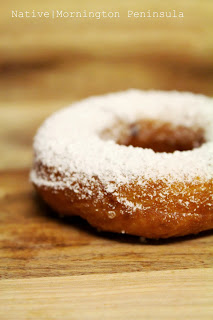I'm sure by now you've heard about Chef Dominique Ansel's trademarked Cronut. The croissant-like doughnut that's fried, filled and glazed. All the hype suggests they'll be the next big thing and I wouldn't be surprised if we start seeing similar creations popping up at bakeries and markets, giving cupcake and macaron makers a run for their money. Curious myself, I've created is a simple (perhaps bastardised) croissant dough and doughnut inspired by Chef Ansel's famous Cronut and had some delicious results.
First up the dough. Looking for simplicity, I used the Mother Dough recipe from Christina Tosi's Momofuku Milk Bar. This is such an easy dough to bring together and it's more than likely you have the ingredients on hand as it's just flour, water, salt and active dry yeast. The croissant's airy layers are created by laminating (rolling and folding) the dough with an unorthodox mixture of cream cheese and butter. The cream cheese imparts a slight sourness to the pastry that will compliment your chosen embellishment be it sweet or savory. I tried mine with home made peach jam, another with a dusting of icing sugar and a croissant classic, ham and cheese.
I know making your own croissant dough can sound daunting but don't let this recipe intimidate you. For success, I've broken the method down into manageable steps that can be completed over a several days. As for cronuts, deep fried croissant dough is just as decadent and indulgent as it sounds and is well worth the effort.
Cream Cheese Croissant Dough
Adapted from Momofuku Milk Bar's Kimchi and Blue Cheese Croissants.Notes: Milk Bar's recipe is worth the read as it has some really good tips on laminating the dough, much more than I was able to cover here. If your feeling adventurous steps listed under Day 1, 2 and 3 can definitely be done in a single day.
Ingredients
MotherDough
275g Plain Flour
1 tsp Salt
2g Active Dry Yeast
185ml Warm Water
Vegetable Oil
Butter Mixture
115g Butter, room temperature
100g Cream Cheese, room temperature
1/2 tsp Salt
1 tbsp Brown Sugar
1 Egg, for glazing
Method
Day 1
Prepare the mother dough and butter mixture. For the mother dough combine the flour, salt and yeast in the bowl of a stand mixer. Add the water and using a dough hook mix on low speed for 3 minutes. Turn the mixer up to the next speed and mix for a further 4 minutes or until the dough is smooth and silky. Place the dough in a lightly oiled bowl, cover with plastic wrap and leave to proof at room temperature for 45 minutes.The dough can now be stored in the fridge for up to three days until your ready to tackle Day 2.
For the butter mixture combine all the ingredients in the bowl of a stand mixer. Using the paddle attachment, beat for 5 minutes or until light and fluffy. Place the butter between two pieces of grease proof paper and flatten into a rough 10x15cm pad. Leaving the paper on, transfer to the fridge to firm up until ready to use.
Day 2
Take the dough out of the fridge and let stand for 40 minutes to come to room temperature. Punch down the dough, dust your work surface lightly with flour, and role out the dough into a rough 20x30cm rectangle. Place the butter pad on one half of the rolled dough. Fold the dough over to cover the butter and pinch the edges closed. Let sit, covered, for 10 minutes.
Working on a lightly dusted work surface, gently roll out the dough into a 20x30cm rectangle. Create a 'double book' turn fold by folding in the short edges over 1/4 of the dough, fold over another 1/4 so the first fold meets in the middle. Then 'close' the book, by folding one short edge over the other. Cover the dough with plastic wrap and return to the fridge for 30 minutes to rest. Repeat the rolling and folding steps at least two more times to ensure nice flaky layers. Return the dough to the fridge until ready to use.
The following diagram shows a cross section of how a double book turn fold is created.
Day 3
Take the dough out of the fridge and rest for 10 minutes. Working on a lightly dusted work surface, gently roll out the dough into a 20x30cm rectangle. To make croissants, cut the dough into triangles 20cm long and about 10cm wide. To make the crescent shape start from the wide end of the triangle and carefully roll the dough towards the pointy end, gently stretching the dough widthwise and lengthwise as you go. Place on a baking tray leaving plenty of room between the croissants. Cover loosely with plastic wrap and let sit at room temperature for 45 minutes to double in size.
Heat the oven to oven to 190°. Whisk the egg with 1/2 tsp of water and generously coat the croissants with a pastry brush. Bake the croissants for about 25 minutes until flaky and golden. They are best eaten the same day as baking but also tasty when reheated or toasted.
Variation:
To make doughnuts, roll the dough out as described under Day 3. Using cookie cutters cut circles and wholes to form the doughnuts. Cover the doughnuts loosely with plastic wrap and let sit at room temperature for 45 minutes to double in size. Deep fry the doughnuts in a vegetable oil that's about 180-190°. When cool dust with icing sugar or glaze with your choice of icing.
















